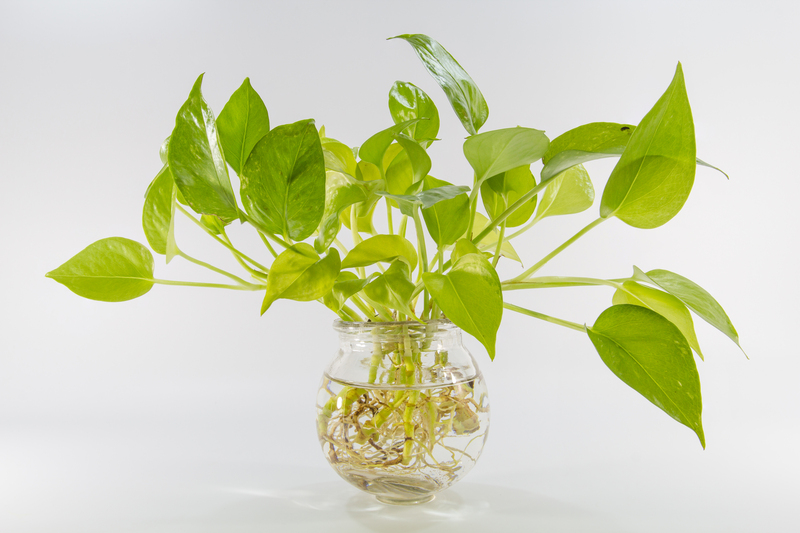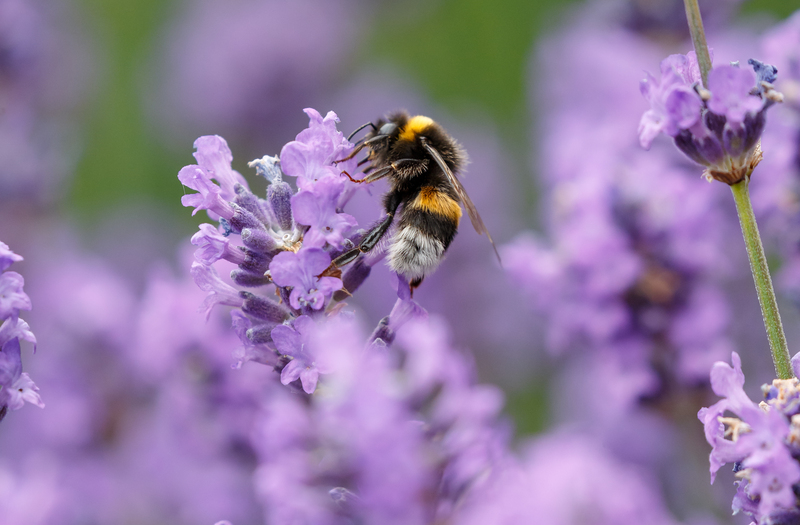Green Alchemy: Turning Everyday Waste into Nutrient-Packed Soil
Posted on 21/09/2025
Green Alchemy: Turning Everyday Waste into Nutrient-Packed Soil
Imagine a world where apple cores, coffee grounds, and wilted lettuce never end up in landfills, but instead transform into rich, black earth overflowing with vitality. This is the magic of green alchemy--the art of turning everyday waste into nutrient-packed soil. By embracing sustainable composting at home, anyone can reduce waste and feed their garden with homemade, eco-friendly fertilizer. In this comprehensive guide, we'll uncover how simple household scraps can become the foundation of flourishing gardens. Discover easy composting methods, key tips, and the environmental benefits of becoming a green alchemist in your own backyard!
The Power of Nutrient-Rich Soil in Sustainable Living
Soil is more than just the ground beneath our feet--it's the beating heart of gardens, landscapes, and food systems. Healthy, living soil teems with microorganisms that break down organic matter, cycle nutrients, and help plants thrive. Unfortunately, much of modern food waste ends up in landfills, contributing to greenhouse gas emissions rather than replenishing the earth.
- Organic matter left unused creates methane, a potent greenhouse gas.
- Landfills fill up faster, accelerating environmental problems.
- Valuable nutrients are lost instead of feeding plants and crops.
By turning kitchen and yard waste into compost--nature's ultimate soil amendment--anyone can contribute to a sustainable future while enriching their own garden. Green alchemy empowers everyone to close the nutrient loop and cultivate a thriving, regenerative landscape.

What Is Green Alchemy? The Science Behind Composting
The Origins of Green Alchemy
The term green alchemy beautifully describes the transformation of everyday organic waste into nutrient-dense soil through composting methods. This alchemical process isn't mystical--it's rooted in biology, chemistry, and environmental stewardship. By mimicking natural decomposition, you can turn banana peels, eggshells, and even paper towels into a garden's greatest treasure.
How Does Composting Work?
Composting is the biological decomposition of organic matter by microorganisms--bacteria, fungi, and earthworms. These organisms consume waste and break it down, producing humus: a stable, nutrient-packed material that improves soil structure and fertility.
- Compost adds vital nutrients like nitrogen, phosphorus, and potassium to the soil.
- It encourages beneficial microbes, fungi, and earthworms.
- Compost improves water retention, reducing the need for frequent irrigation.
The alchemy of composting lies in balancing "greens" (nitrogen-rich materials) and "browns" (carbon-rich materials), managing moisture, and allowing adequate airflow. We'll cover more about these essentials later in the article!
Types of Composting: Finding Your Green Alchemy Recipe
Green alchemy is far from one-size-fits-all. Below are popular methods suitable for different lifestyles and environments. The method you choose will depend on available space, climate, and goals.
Traditional Backyard Composting
- Description: The classic method involves heaping organic waste in a pile or bin and regularly turning it.
- Materials: Grass clippings, leaves, fruit and vegetable scraps, eggshells, coffee grounds, shredded paper, cardboard (avoid glossy or colored print).
- Pros: Cost-effective, scalable, and produces large amounts of compost for gardens or lawns.
- Tips: Alternate layers of "greens" and "browns." Keep the pile moist, like a wrung-out sponge. Turn the pile every few weeks to aerate.
Best for: Homeowners with gardens or yards and enough space for a compost heap or bin.
Vermicomposting (Worm Composting)
- Description: Uses special worms--typically red wigglers--to break down food scraps in a contained bin.
- Materials: Fruit and vegetable peels, coffee grounds, tea bags, paper shreds; avoid meat, dairy, and oily foods.
- Pros: Compact, odor-free, and perfect for apartments or indoor use. Produces "worm castings," nature's superfood for plants.
- Tips: Maintain moisture and feed the worms regularly but avoid overloading the bin to prevent odor issues.
Best for: Apartment dwellers, classroom projects, or anyone eager for a hands-on, fast composting experience.
Bokashi Composting
- Description: Handles all types of food waste--including meat and dairy--using a special inoculant to "pickle" scraps anaerobically in a sealed bucket.
- Materials: Any food waste, including those not traditionally composted.
- Pros: Fast results, almost no odor, and minimal space required. Produces compost tea, a rich liquid fertilizer.
- Tips: Layer waste with bokashi bran, keep tightly sealed, and after fermentation, bury the mixture in soil or add to a compost heap.
Best for: Urban dwellers, small-space gardeners, and those wanting to compost all kitchen scraps.
Tumbler Composting
- Description: Uses a rotating drum, making aeration and mixing simple and quick.
- Materials: As with traditional composting: greens and browns.
- Pros: Neat, fast, pest-resistant, and less labor-intensive.
- Tips: Turn the tumbler every few days. Chop materials small for faster decomposition.
Best for: Busy gardeners or those with limited time and a need for a tidy solution.
What Everyday Waste Can You Use to Make Nutrient-Packed Soil?
The heart of green soil alchemy is knowing which materials fuel rich, living compost. Here's what you can--and shouldn't--add to your compost mix.
Top "Greens" (Nitrogen Sources)
- Fruit and vegetable peels
- Coffee grounds and filters
- Tea bags (remove staples)
- Fresh grass clippings
- Eggshells (crushed for faster breakdown)
Top "Browns" (Carbon Sources)
- Dry leaves
- Paper towels and napkins (plain, unbleached)
- Shredded newspaper
- Cardboard (plain, torn into pieces)
- Wood chips and sawdust (untreated)
What Not to Compost
- Meat and dairy (unless using bokashi)
- Oily foods
- Diseased plant material
- Glossy or coated papers
- Pet feces (may contain harmful pathogens)
Pro Tip: Chop or shred compost materials into smaller pieces before adding. This increases surface area and speeds up decomposition, resulting in finer and more nutrient-dense compost.
The Art and Science of Balancing your Compost
Composting is a living process. The key lies in maintaining the proper ratio of greens to browns, moisture, and airflow. Here's how to master your compost pile's ecosystem for maximum green alchemy results.
Optimal Green/Brown Ratio
- Ideal ratio: About 2-3 parts carbon-rich browns to 1 part nitrogen-rich greens.
- Too green: Pile becomes slimy and may smell unpleasant.
- Too brown: Decomposition slows; pile stays dry and inactive.
Moisture Management
- Keep the pile as moist as a wrung-out sponge but not soggy.
- If compost is too wet, add dry browns like leaves or shredded paper.
- If too dry, sprinkle with water.
Turning the Pile
- Regular turning introduces oxygen, which speeds the breakdown process and prevents foul odors.
- Turn every 1-2 weeks for fastest results.
- Worm and bokashi systems typically need less turning.
Finishing Touches: When is Compost Ready?
- Rich, earthy smell (not rotten or sour)
- Dark brown or black color
- Crumbly texture
- Original materials no longer recognizable
The finished product is pure green alchemy--living soil that feeds plants, locks in moisture, and supports a thriving ecosystem.
Environmental and Economic Benefits of Home Composting
Why Become a Green Alchemist?
- Reduces household waste by up to 30%.
- Decreases reliance on chemical fertilizers and pesticides.
- Improves soil structure and retains water--vital in drought-prone regions.
- Sequesters carbon and lowers your household's carbon footprint.
- Saves money on bagged compost and garden fertilizers.
By choosing nutrient-packed soil alchemy over landfill disposal, you're supporting a healthier, more resilient planet while nurturing your vegetables, flowers, and landscape. Composting empowers everyone to take environmental action at home, one banana peel at a time!
Common Challenges and Solutions in Homemade Composting
Even the most passionate green alchemist may face obstacles on their composting journey. Here are solutions to common pitfalls so you can keep your compost thriving:
Odor Issues
- Problem: Smells like ammonia or rotting food.
- Solution: Add carbon-rich browns. Check green/brown balance. Turn the pile more often to boost oxygen.
Pests and Critters
- Problem: Bugs, ants, or even raccoons and rodents.
- Solution: Bury food scraps deeper. Cover pile with leaves or straw. Secure lid on bins or use tumblers with tight seals.
Slow Decomposition
- Problem: Pile stays intact for months.
- Solution: Chop waste smaller. Add more greens. Mix pile regularly. Moisten if the pile is dry.
Best Practices for Creating Supercharged Nutrient-Rich Soil
- Shred or chop all materials before adding to accelerate breakdown.
- Start your pile with coarse material (twigs or straw) to help aerate the base.
- Keep a container in your kitchen to collect daily scraps for easy transport to the compost bin.
- Layer food waste and yard debris to maintain a balanced, active pile
- Use a thermometer to monitor pile temperature (ideally 130-160?F for active composting).
Apply your finished compost liberally to flower beds, vegetable gardens, trees, or even as topdressing on your lawn. Mix 2-3 inches into planting beds each season for best results.

From Waste to Wonder: Real-Life Compost Success Stories
- The Urban Gardener: Alicia, a city apartment dweller, started with a simple worm bin under her sink and now grows herbs and vegetables on her balcony--all nourished by homemade worm castings.
- The Backyard Farmer: The Rodriguez family diverts all their kitchen scraps to a tumbler and saves hundreds annually on fertilizer, producing enough compost to share with neighbors.
- The Community Compost: Greendale Elementary channels food waste from the school cafeteria into a neighborhood compost bin, turning lunch scraps into a lush garden grown by students--and inspiring future green alchemists!
The Future of Green Alchemy: Small Steps, Big Impact
Turning everyday waste into nutrient-packed soil is an empowering act of environmental stewardship. With simple steps--choosing the right method, feeding your pile, and caring for your compost--anyone can harness the power of green alchemy in their kitchen, backyard, or even on a balcony.
Each compost pile is a catalyst for change. Together, millions of small-scale efforts restore soils, reduce landfill pressure, and feed a hungry planet.
If you're new to composting, start today. Save your peels, brew your coffee, and witness the extraordinary transformation that connects you directly with nature's cycle. Green alchemy isn't just about waste--it's about hope, renewal, and a greener future for all.
Are you ready to become a Green Alchemist?
- Set aside a bin or pile for kitchen scraps and garden waste.
- Choose a composting method that fits your lifestyle.
- Balance, turn, and nourish your pile regularly.
- Spread the magic throughout your garden and community.
Your journey to turning everyday waste into nutrient-packed soil begins with just one peel, one coffee ground, and one inspired decision. Join the green alchemy revolution today!
```


